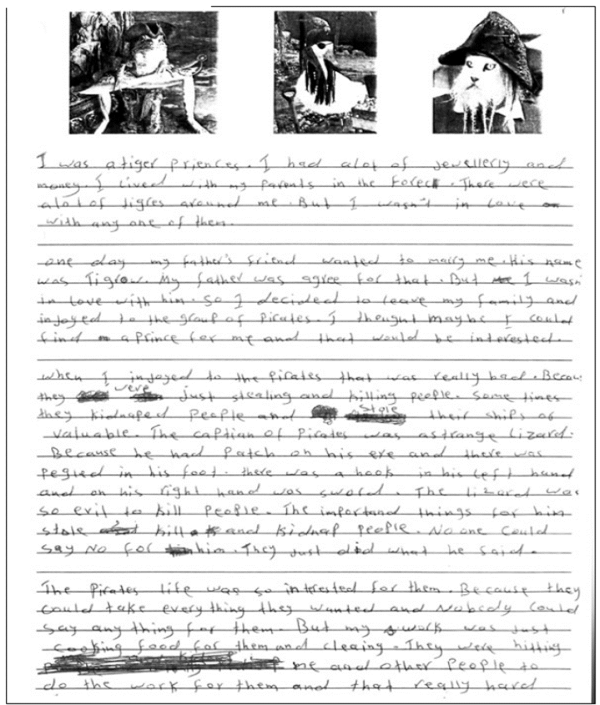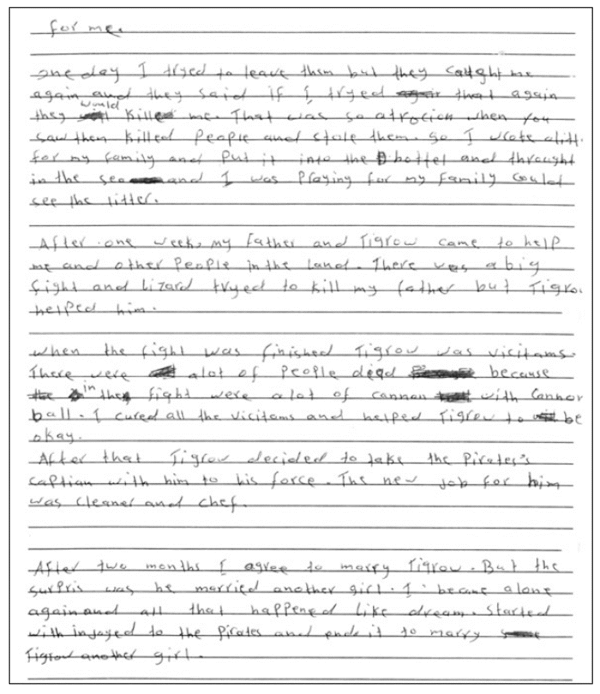Student information
The student is 17 years old. She came from Iraq to Australia via Syria and speaks Arabic and Assyrian as her home languages. She has had age-equivalent schooling and literacy in Arabic before coming to Australia six months ago.
Task
Students brainstormed pirate words on the board. They were shown a set of pictures of different characters. Students chose one of the characters and wrote a first-person narrative independently.
The analysis is based on the student’s writing before correction.


Text
I was a tiger priences. I had a lot of jewellerly and money. I lived with my parents in the Forec. There were a lot of tigres around me. But I wasn’t in love with any one of them.
one day my father’s friend wanted to marry me. His name was Tigrow. My father was agree for that. But I wasn’t in love with him. So I decided to leave my family and injoyed to the group of pirates. I thought maybe I could find a Prince for me and that would be interested.
when I injoyed to the pirates that was really had. Becaus they were just stealing and killing people. Some times they kidnaped people and stole their ships or valuable. The captian of pirates was astrange lizard. Because he had Patch on his eye and there was pegied on his foot. there was a hook in his left hand and on his right hand was sword. The lizard was so evil to kill people. The importand things for him stole kill and kidnap people. No one could say No for him. They just did what he said.
The pirates life was so interested for them. Because they could take everything they wanted and Nobody could say anything for them. But my work was just cooking food for them and cleaning. They were hitting me and other people to do the work for them and that really hard for me.
one day I tryed to leave them but they caught me again and they said if I tryed that again they would kill me. That was so atrocion when you saw them killed people and stole them. So I wrote alitt for my family and Put it into the hottel and throught in the sea and I was prayig for my family could see the litter.
After one week, my father and Tigrow came to help me and other people in the land. There was a big fight and lizard tryed to kill my father but Tigrow helped him.
when the fight was finished Tigrow was vicitams. There were alot of people dead because in the fight were alot of cannon with Cannon ball. I cured all the vicitams and helped Tigrow to be okay.
After that Tigrow decided to take the Pirates’s captian with him to his force. The new job for him was cleaner and chef.
After two months I agree to marry Tigrow. But the surpris was he married another girl. I became alone again and all that happened like dream. started with injoyed to the Pirates and ends it to marry Tigrow another girl.
This sample of student work demonstrates that the student can:
- Write short, simple texts for varied social purposes (VCEALC589)
- Attempt paragraphs and topic sentences (VCEALL598)
- Use simple cohesive devices to structure writing (VCEALL599)
- Use single-word subject–verb–object word order in simple sentences and noun–pronoun agreements with few errors (VCEALL600)
- Use single clauses, or use simple coordinating and subordinating conjunctions to combine clauses (VCEALL601)
- Experiment with different tenses and use some common irregular past tense verbs correctly (VCEALL602)
- Use basic qualifiers and quantifiers to express a range of meaning (VCEALL603)
- Use grapho-phonic knowledge to attempt to spell unknown words (VCEALL606)
- Use common punctuation with some consistency (VCEALL607)
Possible next steps for this student's learning
- Using a bilingual dictionary to check the spelling, meaning and home language translation of commonly misspelt English words to include in a personal word list (VCEALA595) (VCEALL604)
- Using capital letters at the beginning of sentences (VCEALL607)
- Learning to use qualifiers to expand noun groups such as a prince who was interested in me (VCEALL603)
- Learning about clauses and identifying run-on sentences that may be separated into different sentences (VCEALL600) (VCEALL601)
Pathways and transitions considerations
A student who is working within the range of Level C1 in any one language mode is not ready to transition to the English curriculum regardless of their proficiency in the other two language modes. This student will continue on Pathway C of the EAL curriculum.